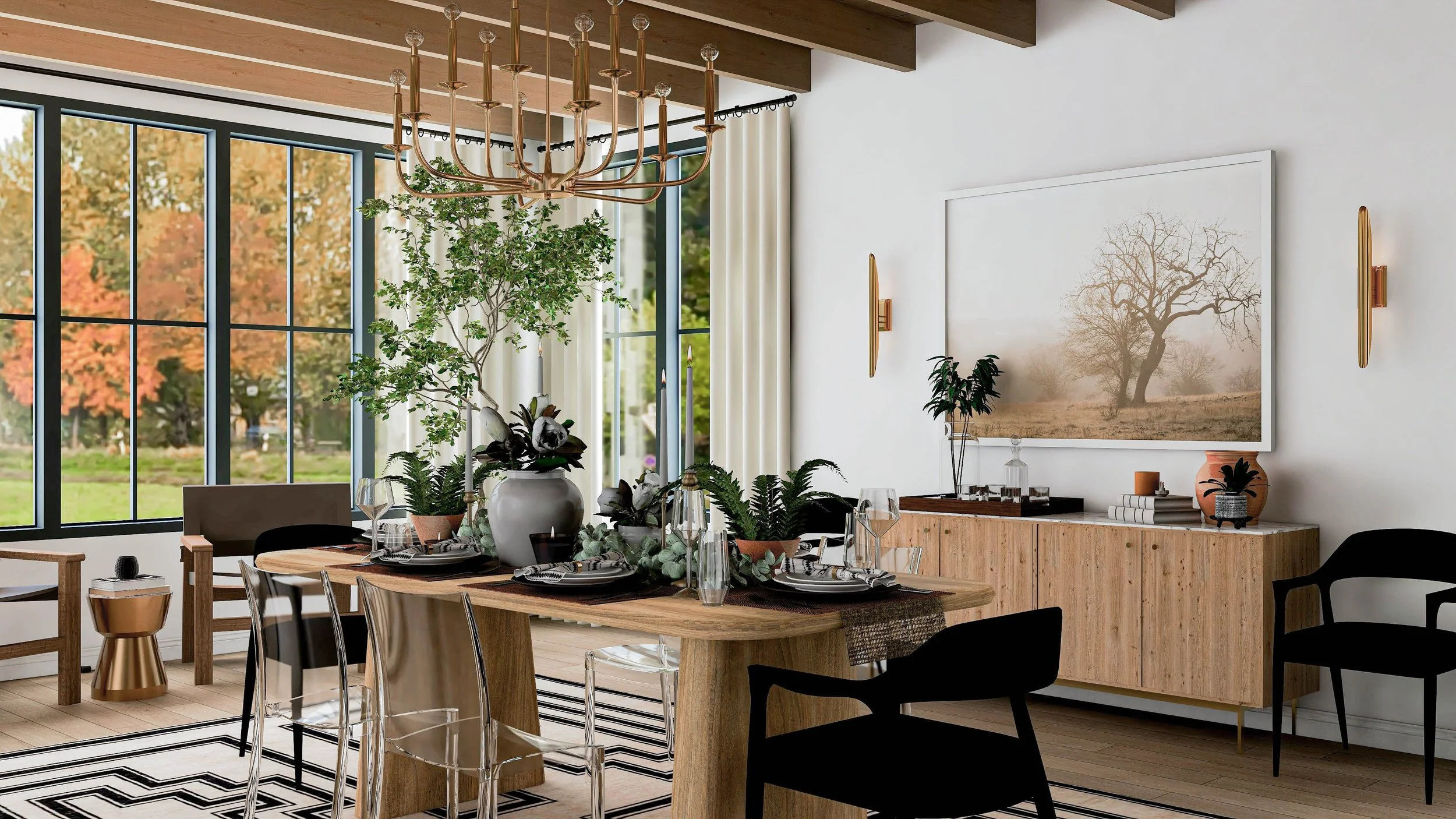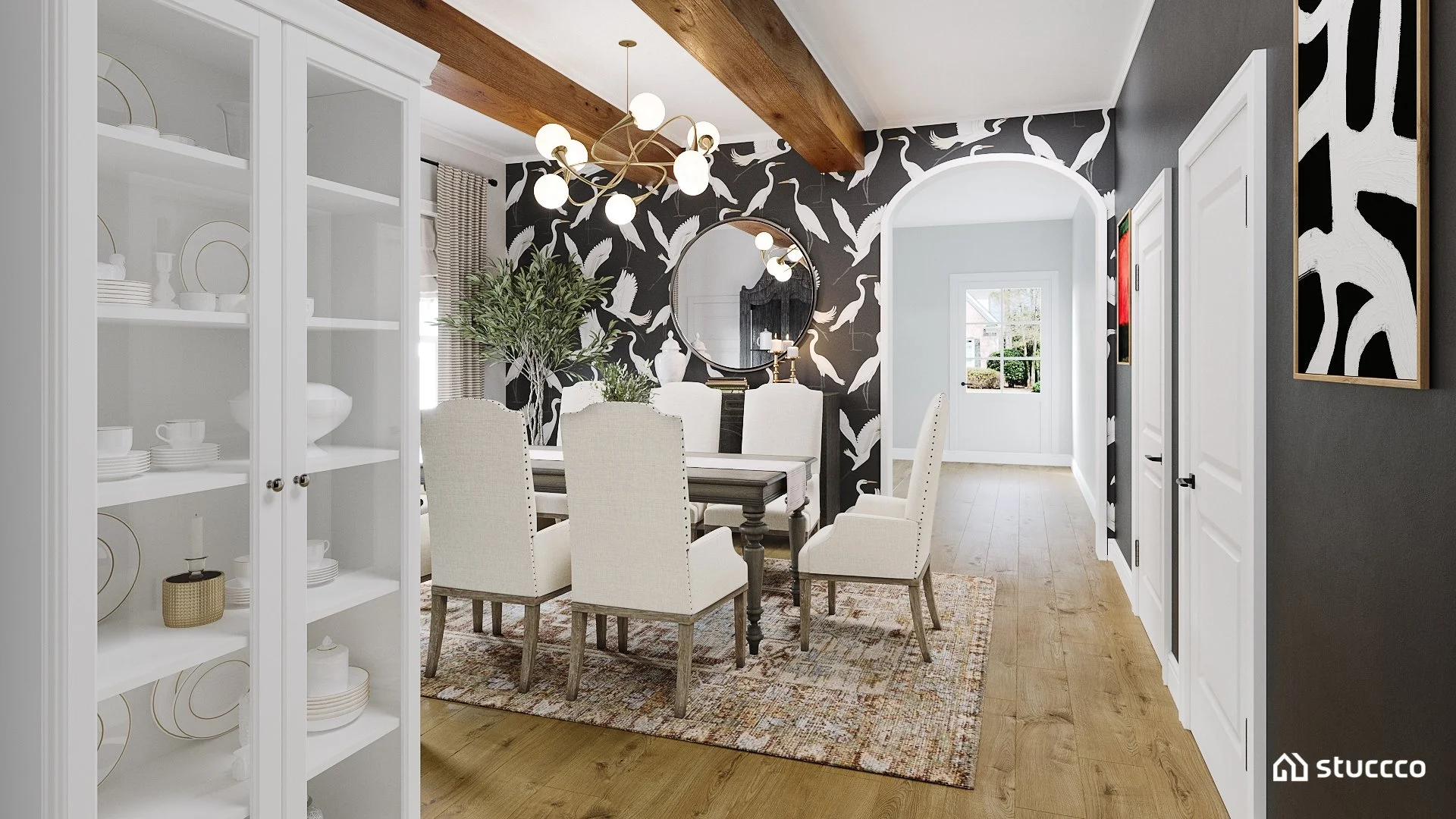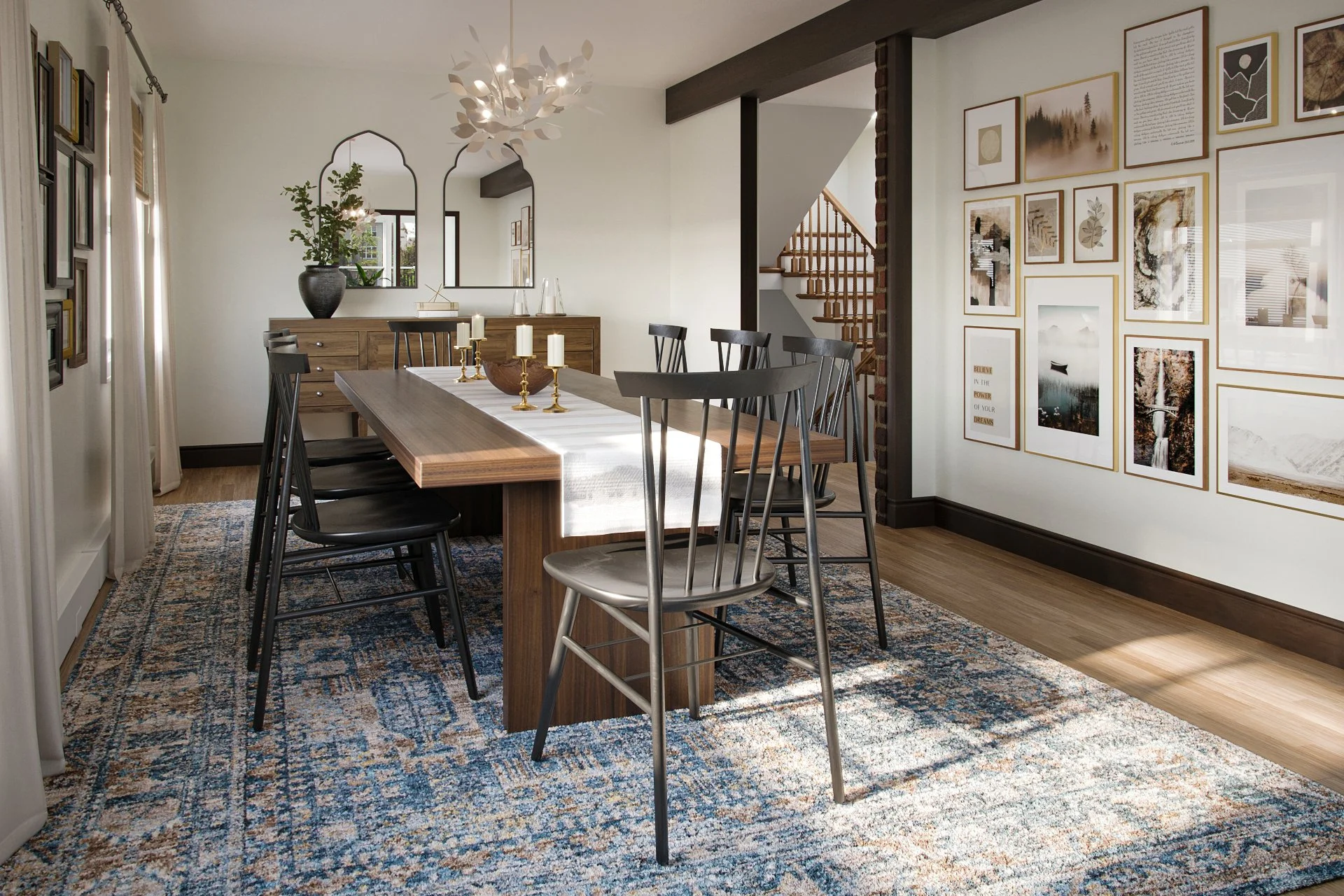The Formal Dining Room Revival: Why It’s Making a Stylish Comeback in Modern Homes
Formal dining rooms have been a staple in home design for centuries, serving as a dedicated space for elegant gatherings and family meals. However, over the past few decades, their popularity waned as open-concept layouts gained traction. Dining spaces often took on more casual roles or were repurposed entirely, transforming into home offices, lounge areas, playrooms, or multipurpose rooms. The rise of informal lifestyles and flexible spaces seemed to spell the end of the traditional formal dining room.
Yet, in the past five years, dining rooms have quietly reentered the design spotlight—albeit in a more relaxed and contemporary fashion. More recently, however, we’re witnessing a remarkable shift: the return of the formal dining room. In just the past year, this dedicated space for hosting and entertaining has been making a stylish comeback for several intriguing reasons.
In this blog, I’ll dive into my observations on this renewed trend, explore what’s driving the resurgence of formal dining rooms, and weigh the pros and cons of embracing this timeless feature in today’s modern home.
California Casual-style formal dining room designed by Joshua Jones of JJones Design Co. The 3D rendering was created by Stuccco.
What Is a Formal Dining Room?
A formal dining room is a dedicated space in a home designed specifically for sit-down meals, often reserved for special occasions, holidays, or entertaining guests. Unlike casual dining areas, which might be part of an open-concept kitchen or living space, formal dining rooms are typically separate from other parts of the home, offering a more structured and intentional setting for meals.
Traditional formal dining rooms often feature a large dining table with matching chairs, coordinated decor, and elements like chandeliers, elegant table settings, and fine china displays. The atmosphere leans toward sophistication and refinement, emphasizing the experience of dining together as a special event.
In their heyday, formal dining rooms symbolized status and tradition, especially in larger homes. However, as lifestyles have become more casual, many people began blending dining spaces with multifunctional areas, causing the formal dining room to fade from prominence—until now. Its resurgence reflects a renewed appreciation for dedicated spaces and the joy of creating memorable experiences over meals.
Rustic Glam-style formal dining room designed by Joshua Jones of JJones Design Co.
What Is Driving the Comeback of Formal Dining Rooms?
Over the past year, the resurgence of the formal dining room seems closely tied to a broader revival of the traditional floor plan. Unlike the open-concept layouts that dominated home design for decades, closed-concept floor plans—with their distinct, enclosed spaces—are becoming increasingly popular. I discuss this trend in greater detail in my blog post, The Great Debate: Open Concept vs. Traditional Floor Plans, where I explore the benefits and drawbacks of each layout style. This shift naturally brings formal dining rooms back into focus as a desirable feature in modern homes.
However, the movement toward formal dining spaces isn’t just about changing floor plans. The end of the COVID-19 pandemic significantly reshaped how people view their homes and social lives. Many have developed a deeper appreciation for hosting intimate gatherings, dinner parties, and events that foster quality time with family, friends, and colleagues. For these occasions, formal dining rooms provide the perfect setting—offering an air of sophistication and a dedicated space for meaningful connections.
Historically, formal dining rooms have played an important role in hosting holiday feasts, business dinners to impress clients or close deals, and other VIP-style events. This legacy of creating memorable experiences seems to be a key motivator for the renewed interest in these spaces. Homeowners are rediscovering the joy and purpose of having a dedicated dining area that reflects both tradition and personal style.
Eclectic-style formal dining room with a whimsical touch, designed by Joshua Jones of JJones Design Co. The 3D rendering was created by Stuccco.
Modern Takes on Formal Dining Rooms
You might be wondering, “Does this mean I have to stick with traditional-style dining rooms, even if they don’t match my home?” Absolutely not! Having a formal dining room doesn’t mean you’re locked into traditional aesthetics. In fact, today’s formal dining rooms are all about blending elegance with personal style, creating unique spaces where memories can be made.
For example, take a look at the 3D rendering of a formal dining room I designed for one of my virtual interior design clients. This eclectic space leans on the whimsical side, making it a one-of-a-kind setup that balances formality with creativity. The beauty of modern formal dining rooms is their versatility—you can adapt them to fit a wide variety of design styles, including Modern Organic, Mid-Century Modern, Scandinavian, and more, while still maintaining a refined atmosphere.
What’s more, formal dining rooms no longer have to exude the overly posh or stiff vibe that might make guests feel uncomfortable. Instead, they can be designed to feel inviting and comfortable, ensuring that everyone feels at ease while still enjoying a special experience. The key is to strike a balance between elegance and approachability, tailoring the space to reflect your personality and lifestyle.
Luxury Modern Organic-style formal dining room designed by Joshua Jones of JJones Design Co., featured in Architectural Digest magazine.
Pros and Cons of Formal Dining Rooms
As with any design choice, formal dining rooms come with their own set of advantages and drawbacks. Understanding these can help you decide whether dedicating a space to formal dining is the right fit for your home and lifestyle.
Pros of Formal Dining Rooms
Elegance and Ambiance: Formal dining rooms create a sense of sophistication and grandeur, making meals feel special and memorable. They’re ideal for hosting holiday feasts, dinner parties, or any occasion where presentation matters.
Defined Space: Unlike open-concept layouts, a formal dining room provides a clear, intentional space for dining. This separation can enhance focus on the meal and the company, free from distractions.
Property Value Boost: Homes with formal dining rooms are often seen as more upscale, potentially increasing their appeal and resale value.
Customization Opportunities: A formal dining room allows you to experiment with design styles and decor that stand apart from the rest of your home, creating a unique space for self-expression.
Cons of Formal Dining Rooms
Underutilization: In some homes, formal dining rooms are only used a few times a year, making them feel like wasted space for day-to-day living.
Space Requirements: A formal dining room requires dedicated square footage, which might not be practical in smaller homes or apartments.
Less Flexible: Unlike multipurpose spaces, a formal dining room has a specific function, which can limit its versatility compared to an open dining area.
Additional Maintenance: Maintaining a separate dining room—especially one with elaborate decor or furniture—requires extra effort to keep it clean and presentable.
By weighing these pros and cons, you can determine whether a formal dining room aligns with your needs and priorities. If you’re someone who loves hosting or cherishes the charm of dedicated spaces, it might be the perfect addition to your home. However, if you value flexibility and practicality, you might want to explore ways to make the space more multifunctional.
Eclectic Country-style formal dining room designed by Joshua Jones of JJones Design Co.
How to Design a Functional and Stylish Formal Dining Room
If you’re planning a new home and want to include a formal dining room, one of the most important factors to consider is the size of the dining table and how many people you want it to accommodate. Surprisingly, this is a common oversight during the design process. The dimensions of the dining table should guide the room’s layout to ensure it fits comfortably while leaving enough space for movement and additional furnishings. There’s nothing more disappointing than realizing your dream dining table doesn’t fit the formal dining room or doesn’t seat the number of guests you envisioned.
For those with an existing dining room—or if you’re considering adding walls to close off an open-concept space—it’s equally essential to evaluate how many seats your table can accommodate. Not all formal dining rooms are spacious enough to fit tables that seat 10 or more people. If your space is limited, you can explore extendable dining tables or more compact layouts to maximize functionality without compromising style.
To create a truly elegant and inviting formal dining room, focus on the following key elements:
Large Dining Table: Ideally extendable, allowing flexibility for larger gatherings.
Comfortable Upholstered Chairs: These add sophistication and ensure long meals are enjoyable.
A Statement Light Fixture: Chandeliers or pendant lighting set the tone for the room’s ambiance.
A Spacious Area Rug: This anchors the space and enhances comfort underfoot.
Buffet Table or Hutch: Perfect for storing dinnerware and serving items, while adding visual interest.
Window Treatments: Draperies or shades not only dress up the room but also control light and privacy.
With thoughtful planning and attention to detail, you can design a formal dining room that is both functional and visually stunning—a space where you’ll love hosting family dinners and special occasions for years to come.
Scandinavian-Glam-style formal dining room designed by Joshua Jones of JJones Design Co. The 3D rendering was created by Stuccco.
Making Room for Elegance and Connection
The resurgence of the formal dining room is a testament to the evolving ways we value our homes and the spaces within them. Whether you’re drawn to the elegance of a traditional setup or prefer a modern twist, a formal dining room can be a meaningful addition to your home. It’s not just about having a place to dine—it’s about creating a space that fosters connection, celebrates special moments, and reflects your personal style.
If you’re feeling inspired but unsure where to start, I can help. Through my virtual interior design and decorating services, I specialize in creating spaces that are not only beautiful but functional, tailored to your unique preferences and needs. Whether you’re designing a formal dining room from scratch or refreshing an existing one, I’ll work with you to bring your vision to life. Let’s create a dining room that’s perfect for hosting, gathering, and making memories.








